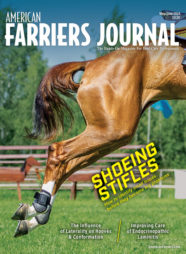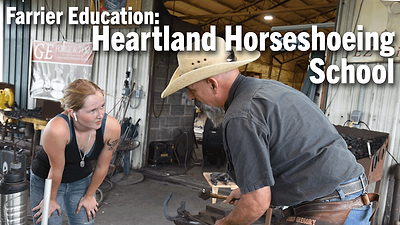While more horses going barefoot has increased the dollar value of offering boots as a footcare option, results from a recent American Farriers Journal survey shows farriers also see numerous hoof health and protection benefits.
Among the farriers responding to this survey, two-thirds buy the boots that are used on horses by their clients. While the remaining one-third indicated that owners purchase the boots, these shoers were recommending styles and brands and making the critical hoof measurements for properly sizing boots.
Boot Benefits

Selecting the proper boot and getting the right fit for a given situation is usually the difference between success and failure. Boots can be dangerous and unreliable when fit by untrained owners or trainers.
Cheryl Swayne finds boots offer increased revenue opportunities for farriers. The Meriden, Kan., farrier found offering boots expanded her footcare options, especially with the growing interest in leaving horses barefoot.
When Cole Henderson got tired of losing business to owners shifting to barefoot horses, he started offering boots to expand his income. “While many feet do well when left barefoot with boots, they don’t suit all customers,” says the Victoria, B.C., farrier.
Pete Ramey believes in leaving many horses barefoot. “The benefits are that boots are removable, offer complete coverage, are flexible, allow loading of the entire foot, provide true axial loading when needed and allow traction to be varied daily or hourly as conditions change,” says the farrier from Lakemont, Ga.
Gretchen Cardoso likes the ability to remove a boot to clean it and check the hoof. “Besides being suitable for occasional hoof protection for bare feet, they are useful for treating certain injuries or pathologies where the hoof is better off without nails,” says the farrier from Makawao, Hawaii.

Esco Buff sees boots as a good option for the customer that has a barefoot horse that needs short-time protection. “Boots are also a good option for every customer to have in a barn or on a trail ride in case a horse loses a shoe so the hoof can continue to be protected,” says the farrier from Webster, N.Y. “They also help with abscess soaking, hoof protection and when gluing on a shoe is too costly for the customer.”
Stephanie Kokal recommends boots for horses coming out of shoes, those recovering from a bad trim or with horses that are ridden on rocky or stony ground. The Greenfield, N.H., farrier has also relied on boots to shift a number of older horses that had been shod to barefoot status.
Laurie Tonita is another farrier who often relies on boots to make the transition from shoes to barefoot for the winter. The Saskatoon, Sask., farrier finds boots offer extra protection and support during the occasional winter ride.
Walter Varcoe sees the major benefit for boots as providing instant protection and sole support for tender feet that should not be shod. The Port Jarvis, N.Y., farrier finds boots are particularly valuable in dealing with hoof injuries, infections and poor environments.
Conor McCarthy urges clients to buy boots for use in an emergency. The shoer from Versailles, Ky., says boots are also valuable with horses that can’t be shod. He finds boots also allow an owner to keep a foot pack dry and still turn the horses out in wet conditions.
Diane Saunders finds boots are good with infrequently used horses that are too tender to go out on a road or trail without some protection. “Boots are also great as a spare tire in case of a lost shoe out on the trail,” says the Bristol, Vt., farrier.

Phil Gendron finds boots are particularly useful for protection with barefoot horses only ridden occasionally. In instances where horses are ridden less than a half dozen times during each shoeing cycle, the Plymouth, Mass., farrier says boots may actually end up being more cost effective than shoes.
“Another good use for boots is with older horses that are no longer being worked, but have poor quality hooves that require protection in rocky turnout,” he says. “Boots also offer good protection for injured or abscessed hooves.”
Shawn Pepper finds boots are useful when a horse tosses a shoe on a long ride. “I have a few clients whose horses are normally barefoot that use boots in parades,” says the Yorba Linda, Calif., farrier.
“These clients typically can’t afford shoes or any special modifications that might be required for a long, slippery parade route where the feet could chip excessively.”
When To Use Boots
McCarthy says the decision to use a boot often boils down to whether the client has one available. “If the weather is bad and they really need to turn the horse out, I may suggest using a boot to protect both the footcare package and the hoof,” he says.
Gendron says deciding whether to use boots should be no different than reaching any other hoof-care decision. “I take into account the horse’s conformation, environment and the desired result,” he says.
Mike DeLeonardo says it boils down to discussing the situation with the client. The key, says the farrier from Salinas, Calif., is coming up with the best solution for both the horse and rider.
Pepper suggests boots only when there doesn’t appear to be any other options. However, he recommends distance riders carry at least one pair of boots with them for emergency use.
“I recommend boots far more for laminitis cases,” he says. “This includes when the client can’t afford therapeutic glue-ons, the concussion of nailing is too painful and the client is invested in providing the necessary care and not just applying a pair of boots and turning the critter out in the back 40.”
Jon Thomas sees boots as a valuable tool to have available whether a horse is shod or barefoot. Yet the Scottsville, Ariz., farrier finds composite shoes are often more convenient for both the owner and horse.

Saunders recommends shoes for a horse with thin walls, thin soles or a foot that is too short. “But if the owner wants to keep the horse barefoot, then the discussion moves to boots and the different types,” she says.
She finds some owners prefer to buy the cheapest pair of boots regardless of what is best for the horse. Other owners want the easiest boot to apply.
“There are so many different types of boots that it’s difficult to keep up with all the products,” she says. “I try to offer recommendations about boots based on my own experiences or the experiences I’ve seen with other owners.”
Cardoso says shoes are her first choice. While she sees boots as a temporary solution, she credits easy removability as a positive feature.
“If a horse is just lame from a myriad of hoof problems, I’ll shoe the feet until the animal improves enough to be sound in the show ring and just needs boots for the trail. If the horse is not comfortable being turned out barefoot, it should be shod.”
Jessica Goonan insists that clients with barefoot horses use boots for trail riding.
“I don’t recommend trail riding without boots or shoes and blatantly tell that to all of my clients,” says the farrier from Goffstown, N.H. “I work with them so they learn when to use them and when not to use them.”
Blue Creek, Ohio, farrier Trudy Ulrich says boots are practical only if the client is willing to put them on every time they ride. “If a client is not comfortable with the idea of using boots, it won’t work,” she says.
What Problems Can Be Helped With Boots?
Goonan finds boots are particularly valuable when dealing with thin hoof walls where it is difficult to nail on shoes. She often places easily changed pads inside boots to deal with laminitis issues. “It seems like most of my laminitic horses are more comfortable in boots and pads,” she says.

Ramey also believes boots can play a key role in laminitis cases. “A padded boot allows the farrier to safely unload the walls and thus the laminae,” he says. “This typically gives immediate relief and allows regrowth of well-connected walls and laminae. The sole can carry more load pressure because the pressure to the solar corium is completely released between strides. This makes boots particularly useful for reversing distal descent of P3.
“Boots and pads also provide relief to navicular horses while encouraging stimulation to underdeveloped frogs, the frog corium, lateral cartilages and digital cushions. Weak-footed horses that hate concussive terrain tend to love the boots over any other type of hoof protection.”
Ulrich often uses boots with navicular horses to increase blood circulation and to serve as a pad without nailing on a shoe. She also recommends boots rather than shoes for some foundered horses.

Tonita uses boots with hoof abscesses as well as with tender-footed horses that aren’t used often enough to warrant shoes. Yet Saunders hasn’t found any situations that couldn’t be solved with either shoes or leaving the horse barefoot.
Swayze finds boots work well with soft feet in a wet spring and to protect feet recovering from an abscess. She also uses boots to protect senior horses that can’t tolerate the concussion from nailing or have too much joint pain to hold their foot up long enough to nail on a shoe.
Varcoe relies on boots for temporary sole coverage, to keep a poultice on the foot and when doing medicinal soaks such as with White Lightning.
Pepper recommends boots as a temporary measure and not as a replacement for physiologically sound shoeing. “They can get a rider by in a pinch if they are on a long ride over rough terrain and their horse loses a shoe or has a stone bruise or hoof puncture,” he says. “They can also be good on a laminitic horse as long as the client provides adequate treatment.
“If a horse is barefoot but must live in their boots or wear them every time they are worked to maintain soundness and horn quality, the horse should probably be in shoes,” he says.
Boot-Fitting Concerns
Goonan finds boot rubbing generally occurs in the heels. She says boot fitting can be a concern if the horse has a longer toe than it should or the horse twists on a hind foot. Tonita adds that an improperly fitting boot can lead to a lost or damaged boot out on the trail.
“Sometimes even a boot that is fitted correctly will rub on the coronet or the heel bulbs,” says Saunders. “If boots are not fit or applied correctly, the horse will sometimes step out of the boot or it won’t provide correct support or protection.”
Ramey says rubbing is normally due to improper fitting. “If they are not fit properly, boots may turn on the foot, fall off or transfer weight bearing too far forward,” he says. “It’s important to rasp the breakover back on most boot treads.”
Henderson’s major concern is with boots that are so big that they tend to rotate on the foot. He finds some boot models are more of a concern than others.
Varcoe finds improper fitting that leads to rubbing on the coronets or heels is a major issue. He also finds boots can leave the hoof damp, which may lead to fungal and bacterial problems.
Linda Cowles says a good trim and proper boot fit are the keys. “If the boots fit, they don’t spin or come off,” says the California trimmer. “Boots are another hoof-care tool that you have to learn to use properly.”
One concern with fitting a boot is that the foot continues to grow every day, says Swanye. Since the longer a customer waits between trims leads to fit issues, she finds it’s important to get booted horses on a regular 4- to 6-week trim schedule.
Boot Problems
The biggest problem Goonan sees with boots is laziness on the part of horse owners. She also doesn’t like how some styles of boots tend to retain water.

Retained moisture in a boot can sometimes make the foot soft. Since dirt and rocks can get into the boots and end up being driven into parts of the hoof, it’s critical that boots always be thoroughly cleaned and dried after each use.
Jonathan Wright agrees that trapped water and dirt can be a concern. The farrier from Tyrnava, Finland, says boots need to be properly fitted to allow the covered hoof to breath.
Saunders says retained moisture in the boot can make the feet soft. “Small pieces of dirt and rocks can get into the boots and end up being driven into the soles or white line,” she says. “Another problem is the lack of ability on the part of end users to fit them properly.”
Swayne finds the biggest problem is trying to talk customers out of using a boot when it would be detrimental to the horse. She says boots don’t always stay on regardless of how carefully the trim is done or the hoof is measured. With boots, she believes it’s essential to trim the horses every 4 to 6 weeks.
Ramey says boots can be dangerous and unreliable when fit by untrained people. “Getting the right boot and the right fit for the given situation is usually the difference between success and failure,” he says. “As with traditional shoeing, there is a great deal of very specific skill, learning and experience that is necessary to consistently succeed with hoof boots.
“As with traditional shoeing, the trim is the most critical aspect. Hoof boots often lead inexperienced, uneducated horse owners into a do-it-yourself mode that can be harmful.”
Cardoso says the shape of each hoof is unique while the shape of most boots is generic. She finds a hoof can change significantly in size between trims as the farrier improves and rehabilitates the hoof, which can result in improper boot sizing. Boots can also twist on the hoof, shift laterally and cause brushing on the corresponding leg due to their bulky size.
Tonita sees chafing around the heel bulbs and the fact that many boots are fairly expensive as major concerns. But if owners rely on boots only when riding and remove them at other times, she says the cost may not be too extreme.
Beth Miles finds thrush can be a major concern if boots aren’t properly cleaned and dried on a daily basis.
The biggest concern Pepper sees is with owners who over use boots. He also doesn’t believe most boots fit as well as they should.

An improperly fitted boot can sometimes lead to a lost or damaged boot when clients are out riding on the trail. Any problems that occur due to the boot rubbing on part of the foot or hoof are normally due to improper fitting of the boot.
“Most of the horses I have seen that frequently wear boots for extended periods of time develop friction sores on their pasterns, coronet bands or heel bulbs along with heel bulb bruising and sometimes gouging of the hoof wall. When clients leave boots on for days at a time, shavings, sand and even gravel can become encased in the boot and injure different structures of the hoof and foot.”
Several of Pepper’s clients wanted to replace shoes with boots on horses being ridden at high rates of speed for more than 25 miles per week.
“These folks were amateur competitive distance riders preparing for their first season of 50-mile rides,” he says. “None of their horses had naturally tough feet to begin with, but they wanted to experiment with barefoot trims and boots rather than having a full set of shoes.
“None of these clients could find a boot that fit well enough to prevent sores from forming even with pastern wraps. In fact, the sores became bad enough that the horses became lame when ridden with boots. The horses were consequently worked barefoot and wore off enough foot in 2 weeks that they became lame.”
Pepper also has concerns about boot users giving their horses too much traction on paved surfaces. “I would think a boot that limits the natural action of sliding and twisting as it pertains to a given conformation would ultimately lead to joint soreness,” he says.








Post a comment
Report Abusive Comment